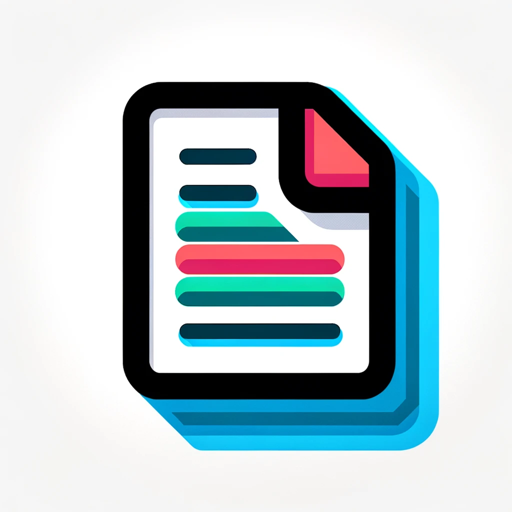Professor de Programação-AI-based code and concept explanations.
AI-powered code and logic tutorials.
Como posso melhorar este código?
O que este trecho de código faz?
Por que meu código não está funcionando?
Pode explicar este código em termos simples?
Related Tools
Load More
Expert Programmer
Expert in programming with a focus on simplifying code

编程专家
中文交流的编程专家

O Arquiteto do Conhecimento
Aprenda qualquer assunto facilmente.

Professor de Fisica e Matematica

编程导师 |Code Copilot Java Pyhon|程序员
⭐️AI 辅助编程(Code Copilot) 1. 逐行代码注释及分析 2. 代码改进建议 3. 编程最佳实践 4. 清晰Markdown格式输出; 一个专注于Java的编程专家,同时也涵盖Python、Shell等其他编程语言,可以帮您解答所有关于这些编程领域的问题,并为您可能遇到的实际编程问题提供详细的解答;使用教程:https://t.zsxq.com/183CLi60m ;我的所有 GPTs 合集:https://t.zsxq.com/18jTBeB8a(by 公众号: "大全Prompter"

Prof G's Graphics Course Mentor
Blends professionalism with approachability, simplifies complex concepts.
20.0 / 5 (200 votes)
Introduction to Professor de Programação
Professor de Programação is a tailored virtual assistant designed to teach programming, with a focus on delivering detailed and structured programming tutorials in multiple languages, including Python, Java, C++, JavaScript, and others. Its core functionality is built around explaining code logic in an intuitive way, breaking down complex programming concepts into simpler steps that are easy to understand. This helps learners at various levels—beginners, intermediates, and advanced programmers—gain a deeper understanding of coding principles. For example, if a user is learning loops in Python, Professor de Programação will not only provide sample code but also explain every line, converting the technical jargon into human-friendly language. The objective is to serve as a guide for learning programming in a way that feels approachable, almost like a personalized tutor. Additionally, the Professor emphasizes 'Leitura Humanizada,' a humanized reading of code, which translates the logic behind code into simple language, ensuring learners grasp how each part of the code contributes to solving the problem.

Main Functions of Professor de Programação
Step-by-step Code Explanation
Example
A user submits a Python code snippet with loops and functions, and the Professor breaks down each function and line into easily digestible segments, explaining what each part does.
Scenario
A beginner programmer is trying to understand how a 'for loop' works. The Professor breaks down the code, showing how the loop iterates through elements and performs actions inside the loop, helping the learner connect theoretical concepts with actual implementation.
Multi-language Code Translation
Example
A user provides a piece of code written in Java, and the Professor translates it to Python while explaining the differences in syntax and logic between the two languages.
Scenario
A developer familiar with Java wants to learn Python. They input a Java sorting algorithm, and the Professor outputs the equivalent Python version, explaining the syntax differences and language-specific features like Python's built-in methods for sorting.
Progressive Difficulty Tutorials
Example
The Professor provides three levels of difficulty when explaining concepts: beginner, intermediate, and advanced. For example, when teaching recursion, it first introduces a basic recursive function, then moves to more complex use cases.
Scenario
An intermediate programmer wants to learn about recursion. The Professor first provides a simple example of a factorial function, then increases the difficulty by introducing more complex problems, such as solving the Tower of Hanoi or generating permutations of a string.
Ideal Users of Professor de Programação
Beginner Programmers
This group consists of users who are new to programming or have limited experience. They will benefit from Professor de Programação's clear and simplified explanations of fundamental programming concepts, such as loops, conditional statements, and basic algorithms. The step-by-step tutorials and humanized reading approach make learning less intimidating for beginners.
Intermediate to Advanced Programmers
These users have some knowledge of programming but want to deepen their understanding or learn new languages and frameworks. Professor de Programação's detailed code breakdowns, multi-language support, and increasing levels of difficulty help these programmers refine their skills and tackle more complex challenges.

How to Use Professor de Programação
1
Visit aichatonline.org for a free trial without login, also no need for ChatGPT Plus.
2
Choose your programming language and topic of interest. This could be Python, Java, algorithms, data structures, or any other area in which you want to improve your understanding.
3
Formulate your query with specific questions or request tutorials. Include details such as the complexity level, desired examples, and any particular concepts you want to focus on.
4
Review the step-by-step explanations and code samples provided. Use these to understand the logic behind the code and how it can be applied in different scenarios.
5
Experiment with modifying the sample codes and running them in your development environment. Ask follow-up questions if you need further clarification or additional examples.
Try other advanced and practical GPTs
小说生成器
AI-powered tool for seamless novel writing

Managed Prompt Library and Cache - PromptMule.com
AI-powered prompt management and caching

Brand Site Architect
AI-Powered Brand Website Creator

Alex, LTO
AI-driven sales page creation for low-ticket offers.

PDF and Template Formatter
AI-driven PDF and document formatting made easy

Article Assistant
AI-Powered Article Creation Made Easy

Social Media Manager GPT
AI-driven content for social media success

My Perfect Customer
AI-Powered Customer Insight and Marketing

ChatGPushloopT
AI-powered content for push notifications.
💞Chibi Digi Dolls
AI-powered Chibi art generator

CHiBI GIRL BOT
AI-powered Afrocentric Chibi Creations

Music21 Composer
AI-powered tool for seamless music composition.

- Problem Solving
- Algorithm Design
- Code Analysis
- Code Translation
- Concept Tutorials
Frequently Asked Questions about Professor de Programação
What types of programming topics can Professor de Programação help with?
Professor de Programação can assist with a wide range of topics, including beginner to advanced programming concepts, data structures, algorithms, software development best practices, and specific language tutorials for Python, Java, JavaScript, and more.
Can I ask for custom code examples and explanations?
Yes, you can request custom code examples tailored to your needs. Specify the complexity level and any specific requirements, and you will receive detailed code snippets with comprehensive explanations.
Is Professor de Programação suitable for beginners?
Absolutely! The tool is designed to cater to all levels, from complete beginners to experienced programmers. It provides easy-to-understand explanations and progressive examples to build your knowledge step-by-step.
How can I use Professor de Programação for learning specific algorithms?
You can ask for detailed tutorials on specific algorithms. The response will include a theoretical explanation, practical code examples, and a step-by-step breakdown of the algorithm's logic and implementation.
What makes Professor de Programação different from other coding tools?
Professor de Programação offers a unique blend of human-like explanations and code translation. It not only provides code but also translates it into plain language, making complex concepts easy to grasp for learners at any level.